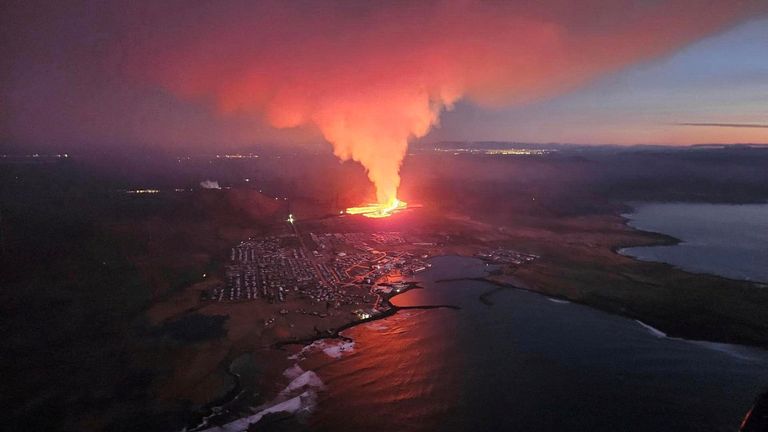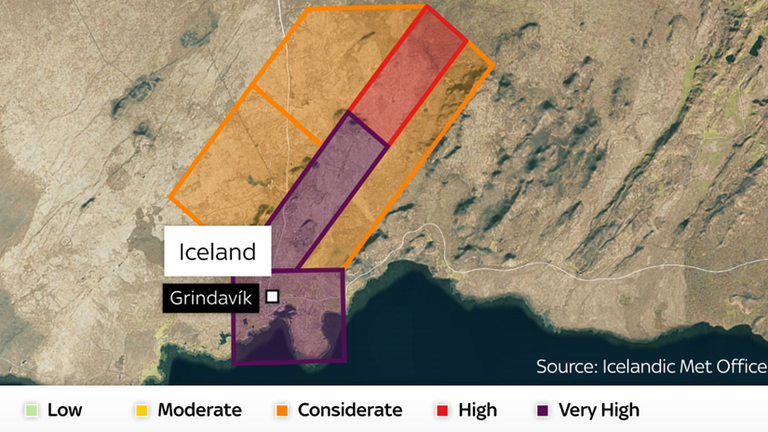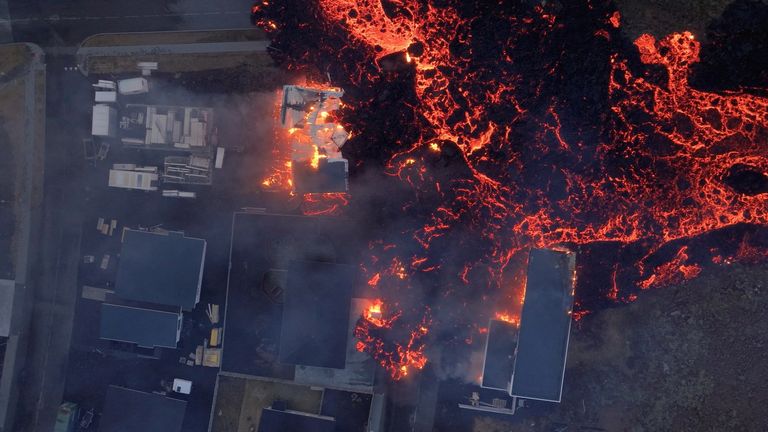Iceland volcano: What we know about the eruption - and its impact on flights
While Iceland is no stranger to volcanic activity with an eruption every four or five years, they can still cause major disruption.
Monday 15 January 2024 13:59, UK
Iceland has suffered its second volcano eruption in less than a month.
Nearly 4,000 people had already been evacuated from the fishing town of Grindavik after the first eruption in December.
But following a series of earthquakes, another fissure opened and began spewing lava nearby in the early hours of 14 January.
Lava 'inside town'; follow Iceland latest
While Iceland is no stranger to volcanic activity with an eruption every four or five years, they can still cause major disruption. Here we look at the latest incident and its impact on travel.
What happened - and where?
Movement first began hundreds of metres below ground at the Reykjanes peninsula in October last year.
Thousands of tremors were measured at the site, which is around 35 miles from the capital Reykjavik.
The volcanic system there was dormant for around 800 years until it erupted in March 2021.
Following three others since then, a 2.5-mile-long fissure emerged north of Grindavik on 18 December, a state of emergency was declared, and residents were evacuated.
At around 3am on 14 January around 200 earthquakes were measured at a nearby site - roughly 900m (0.6 miles) away from Grindavik.
Hours later, just before 8am, the volcano erupted, southeast of Helgafell mountain, with a second fissure opening just after midday.
According to Iceland's Met Office, the fissure is "south of lava flow detection barriers being built north of Grindavik" and "lava is now flowing towards the town".
Science correspondent Thomas Moore, who is in the area, says activity has "eased off overnight" and the second fissure "appears to have stopped" producing lava.
He reports three houses have been "consumed" and defence walls that were being built north of the town have been breached where they were incomplete.
A man has also been reported missing and suspected to have fallen into one of the cracks while working to fill the crevasses formed by earthquakes.
Professor Magnus Tumi Guomundsson, an expert in geophysics at the University of Iceland, adds that this eruption is "somewhat bigger" than previous incidents nearby.
Is it affecting travel - and what if I've got a holiday booked?
Despite the dramatic scenes, so far only nearby roads have been closed.
The eruption site is 10 miles from Keflavik airport, which operates flights to London and elsewhere in the UK with EasyJet, WhizzAir, British Airways, TUI, Icelandair, and Play.
There has been no disruption to planes landing and taking off there - or at Reykjavik.
The Foreign, Commonwealth and Development and Office (FCO) travel advice currently says that "Keflavik International Airport is operating as normal" and "Reykjavik and the rest of Iceland have not been impacted".
While many may remember the 2010 volcano eruption in Iceland and the ash cloud it produced that closed airspace for more than a week, nothing of that scale is expected.
Dr Sam Mitchell, research associate in volcanology at the University of Bristol, said: "This is a very different eruption to that of Eyjafjallajokull in 2010 where a large explosive eruption under a glacier produced a very large cloud and very fine ash in the atmosphere when the wind direction was pointing towards mainland Europe."
He added: "It is very difficult to say how long these eruptions will last; it could be days, it could be months. Larger more intense eruptions tend to last a shorter time, but if the flow rate becomes small it could go on for some time."
Blue Lagoon closed
The only tourist site affected is the Blue Lagoon thermal spa, which is around four miles away and closed until at least 16 January.
Anyone with a booking is entitled to reschedule or request a refund, according to its website.
As official travel advice does not warn against going to Iceland, rescheduling a flight/holiday will come at a cost - and there will be no insurance cover for those who choose not to fly.
Why is Iceland so prone to natural disasters?
Iceland is one of the most volcanic regions on the planet, sitting on the mid-Atlantic ridge, where the tectonic plates of North America and Eurasia pull apart from one another at a rate of around 2cm a year.
Over millions of years, a plume of molten rock poured from the rift, eventually breaching the ocean surface to form what is now Iceland.
On average there is an eruption from one of the country's 32 active volcanoes every four or five years, with rivers of lava shaping the stark landscape.
At this time of year, when daylight is scarce, rescue and other operations become more difficult.



